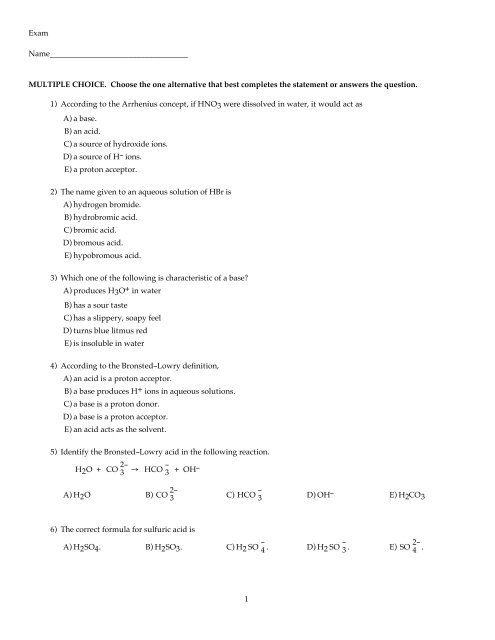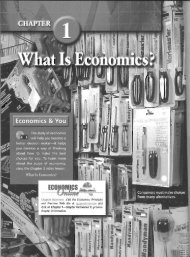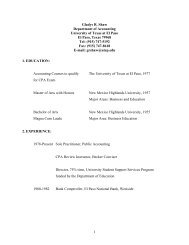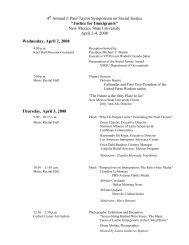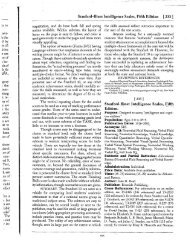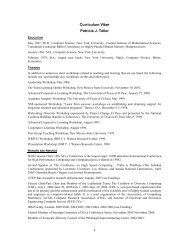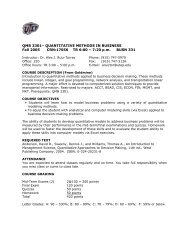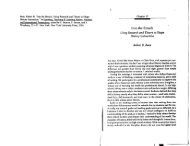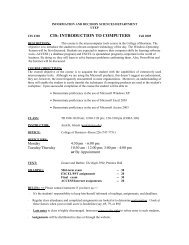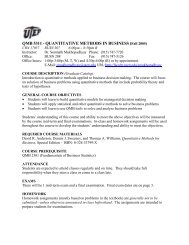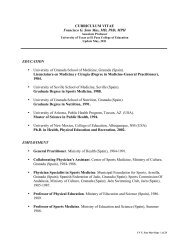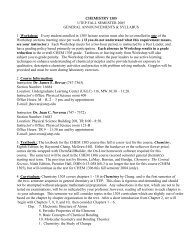Exam - Faculty.utep.edu
Exam - Faculty.utep.edu
Exam - Faculty.utep.edu
Create successful ePaper yourself
Turn your PDF publications into a flip-book with our unique Google optimized e-Paper software.
<strong>Exam</strong><br />
Name___________________________________<br />
MULTIPLE CHOICE. Choose the one alternative that best completes the statement or answers the question.<br />
1) According to the Arrhenius concept, if HNO3 were dissolved in water, it would act as<br />
A) a base.<br />
B) an acid.<br />
C) a source of hydroxide ions.<br />
D) a source of H- ions.<br />
E) a proton acceptor.<br />
2) The name given to an aqueous solution of HBr is<br />
A) hydrogen bromide.<br />
B) hydrobromic acid.<br />
C) bromic acid.<br />
D) bromous acid.<br />
E) hypobromous acid.<br />
3) Which one of the following is characteristic of a base<br />
A) produces H3O+ in water<br />
B) has a sour taste<br />
C) has a slippery, soapy feel<br />
D) turns blue litmus red<br />
E) is insoluble in water<br />
4) According to the Bronsted-Lowry definition,<br />
A) an acid is a proton acceptor.<br />
B) a base produces H+ ions in aqueous solutions.<br />
C) a base is a proton donor.<br />
D) a base is a proton acceptor.<br />
E) an acid acts as the solvent.<br />
5) Identify the Bronsted-Lowry acid in the following reaction.<br />
H2O + CO 2-<br />
3 ¬ HCO - 3 + OH -<br />
A) H2O B) CO 2-<br />
3 C) HCO - 3 D) OH- E) H2CO3<br />
6) The correct formula for sulfuric acid is<br />
A) H2SO4. B)H2SO3. C)H2 SO - 4 . D)H 2 SO - 2-<br />
3 . E) SO 4 .<br />
1
7) The name of Al(OH)3 is<br />
A) aluminum trihydroxide.<br />
B) monoaluminum trihydroxide.<br />
C) aluminum hydroxide.<br />
D) aluminum(III) hydroxide.<br />
E) aluminum oxygen hydride.<br />
8) Which of the following is the strongest acid<br />
A) H3PO4 B) NH + 4 C) NaOH D) H2CO3 E) HCl<br />
9) Which of the following is correctly identified<br />
A) NH3, strong acid<br />
B) NaOH, strong base<br />
C) HCl, weak acid<br />
D) H2CO3, strong acid<br />
E) Ca(OH)2, weak base<br />
10) Ammonium hydroxide is a weak base because<br />
A) it is a dilute solution.<br />
B) it is only slightly soluble in water.<br />
C) it cannot hold on to its hydroxide ions.<br />
D) it dissociates only slightly in water.<br />
E) it is completely ionized in aqueous solution.<br />
11) An acid and base react to form a salt and water in a(n) _____ reaction.<br />
A) ionization B) dissociation C) oxidation D) neutralization E) r<strong>edu</strong>ction<br />
12) In a neutralization reaction<br />
A) two acids react to form water.<br />
B) water and a salt react to form an acid and a base.<br />
C) an acid and a salt react to form water and a base.<br />
D) a base and a salt react to form water and an acid.<br />
E) an acid and a base react to form a salt and water.<br />
2
13) Which of the following is the correctly balanced equation for the complete neutralization of H3PO4 with Ca<br />
(OH)2<br />
A) H3PO4 + Ca(OH)2 ¬ CaHPO4 + 2H2O<br />
B) 3H3PO4 + Ca(OH)2 ¬ Ca3(PO4)2 + 5H2O<br />
C) H3PO4 + Ca(OH)2 ¬ Ca3(PO4)2 + H2O<br />
D) 2H3PO4 + 3Ca(OH)2 ¬ Ca3(PO4)2 + 6H2O<br />
E) 4H3PO4 + 6Ca(OH)2 ¬ 2Ca3(PO4)2 + 12H2O<br />
14) The neutralization reaction between Al(OH)3 and HNO3 produces the salt with the formula<br />
A) H2O. B) AlNO3. C) AlH2. D) Al(NO3) 3. E)NO3OH.<br />
15) How many moles of H2O are produced when 1 mole of Mg(OH)2 reacts with 1 mole of H2SO4<br />
A) 1 B) 2 C) 3 D) 4 E) 5<br />
16) Which of the following is a neutralization reaction<br />
A) KCl + NaNO3 ¬ KNO3 + NaCl<br />
B) HNO3 + KOH ¬ H2O + KNO3<br />
C) H2O + SO3 ¬ H2 SO 4<br />
D) 4Na + O2 ¬ 2Na2O<br />
E) 2NO2 ¬ 2NO + O2<br />
17) What is the molarity of a KCl solution made by diluting 75.0 mL of a 0.200 M solution to a final volume of 100.<br />
mL<br />
A) 0.267 M B) 0.150 M C) 0.200 M D) 6.67 M E) 0.100 M<br />
18) What volume of 2.5% (m/v) KOH can be prepared from 125 mL of a 5.0% KOH solution<br />
A) 0.0040 mL B) 63 mL C) 0.10 mL D) 125 mL E) 250 mL<br />
19) What volume of 0.10 M NaOH can be prepared from 250. mL of 0.30 M NaOH<br />
A) 0.075 L B) 0.25 L C) 0.75 L D) 0.083 L E) 750 L<br />
20) What volume of a 2.00 M KCl solution is required to prepare 500. mL of a 0.100 M KCl solution<br />
A) 0.0400 mL B) 25.0 mL C) 2.00 mL D) 1.00 x 104 mL E) 5.00 x 102 mL<br />
3
21) What is the new mass/volume (m/v)% of a KOH solution that is prepared by diluting 110 mL of a 6% (m/v)<br />
KOH solution to 330 mL<br />
A) 2% B) 1% C) 6% D) 12% E) 18%<br />
22) A 25.0 mL sample of H3PO4 requires 50.0 mL of 1.50 M NaOH for complete neutralization. What is the<br />
molarity of the acid<br />
H3PO4 + 3NaOH ¬ Na3PO4 + 3H2O<br />
A) 0.333 M B) 3.00 M C) 1.50 M D) 1.00 M E) 0.750 M<br />
23) A 25.0 mL sample of H2SO4 requires 20.0 mL of 2.00 M KOH for complete neutralization. What is the molarity<br />
of the acid<br />
H2SO4 + 2KOH ¬ K2SO4 + 2H2O<br />
A) 2.00 M B) 2.50 M C) 0.800 M D) 1.60 M E) 1.25 M<br />
24) How many milliliters of 0.400 M NaOH are required to completely neutralize 20.0 mL of 0.200 M HCl<br />
A) 50.0 mL B) 40.0 mL C) 0.100 mL D) 20.0 mL E) 10.0 mL<br />
25) How many milliliters of 0.200 M NaOH are required to completely neutralize 5.00 mL of 0.100 M H3PO4<br />
A) 7.50 mL B) 2.50 mL C) 0.833 mL D) 5.00 mL E) 15.0 mL<br />
26) How many milliliters of 0.100 M Ba(OH)2 are required to neutralize 20.0 mL of 0.250 M HCl<br />
A) 100. mL B) 50.0 mL C) 25.0 mL D) 0.250 mL E) 0.50 mL<br />
27) When a piece of magnesium metal is added to hydrochloric acid, what gas is produced<br />
A) oxygen B) chlorine C) nitrogen D) carbon dioxide E) hydrogen<br />
28) How many mL of a 0.0100 M solution can be made from 100.0 mL of a 1.00 M solution of sodium chloride in<br />
water<br />
A) 100 mL B) 500 mL C) 1000 mL D) 5000 mL E) 10,000 mL<br />
For the next two problems, consider the reaction in which magnesium reacts with an HCl solution .<br />
Mg(s) + 2HCl(aq) ¬ MgCl2(aq) + H2(g)<br />
29) If 2.00 g of Mg reacts completely with 50.0 mL of HCl solution, what is the molarity of the HCl solution<br />
A) 1.65 M B) 80.0 M C) 8.00 M D) 0.823 M E) 3.29 M<br />
30) If 2.00 g of Mg reacts with an excess HCl solution, how many liters of hydrogen gas are produced at STP<br />
A) 3.69 L B) 1.84 L C) 5.53 L D) 22.4 L E) 0.165 L<br />
SHORT ANSWER. Write the word or phrase that best completes each statement or answers the question.<br />
31) The conjugate acid of HPO4 2- is _____.<br />
4
32) Is a solution of sodium phosphate in water acidic or basic<br />
33) In a titration experiment, a student used 24.13 mL of 0.111 M sodium hydroxide to neutralize 20.00 mL of a<br />
hydrochloric acid solution. What was the molarity of the acid solution<br />
34) A student had 2.0 L of a sodium hydroxide solution that had a concentration of 0.4000 M. The student needed<br />
to make 500 mL of a 0.1000 M solution. How many mL of the concentrated solution was needed<br />
35) A student had 5.0 L of a sulfuric acid solution available, that had a concentration of 1.000 M. The student<br />
needed to make 200.0 mL of a 0.2000 M solution. How much of the concentrated solution was needed<br />
TRUE/FALSE. Write 'T' if the statement is true and 'F' if the statement is false.<br />
36) An ammonium chloride solution should have an acidic pH.<br />
37) Magnesium metal is not attacked by sulfuric acid solutions.<br />
38) Sodium carbonate gives a basic solution in water.<br />
39) For most reactions of acids with bases, the resulting products are a salt and water.<br />
MATCHING. Choose the item in column 2 that best matches each item in column 1.<br />
Identify each of the following compounds as an acid, a base, or neither.<br />
40) HCl<br />
A) acid<br />
41) NaOH<br />
42) NH3<br />
B) neither<br />
C) base<br />
43) H2SO4<br />
44) CO 2-<br />
3<br />
45) NaCl<br />
46) CN-<br />
47) H2CO3<br />
MULTIPLE CHOICE. Choose the one alternative that best completes the statement or answers the question.<br />
48) The O-H bond in water is polar because<br />
A) it is an ionic bond.<br />
B) oxygen is much more electronegative than hydrogen.<br />
C) oxygen occupies more space than hydrogen.<br />
D) hydrogen is much more electronegative than oxygen.<br />
E) it is a hydrogen bond.<br />
5
49) A hydrogen bond is<br />
A) an attraction between a hydrogen atom attached to N, O, or F and an N, O, or F atom.<br />
B) a covalent bond between H and O.<br />
C) an ionic bond between H and another atom.<br />
D) a bond that is stronger than a covalent bond.<br />
E) the polar O-H bond in water.<br />
50) In a solution, the solvent<br />
A) is a liquid.<br />
B) can be a liquid or gas.<br />
C) can be a solid, liquid, or gas.<br />
D) is never a solid.<br />
E) is the substance present in the smallest concentration.<br />
51) A solution is prepared by dissolving 2 g of KCl in 100 g of H2O. In this solution, H2O is the<br />
A) solute.<br />
B) solvent.<br />
C) solution.<br />
D) solid.<br />
E) ionic compound.<br />
52) Oil does not dissolve in water because<br />
A) oil is polar.<br />
B) oil is nonpolar.<br />
C) water is nonpolar.<br />
D) water is saturated.<br />
E) oil is hydrated.<br />
53) When KCl dissolves in water<br />
A) the Cl- ions are attracted to dissolved K+ ions.<br />
B) the Cl- ions are attracted to the partially negative oxygen atoms of the water molecule.<br />
C) the K+ ions are attracted to Cl- ions on the KCl crystal.<br />
D) the K+ ions are attracted to the partially negative oxygen atoms of the water molecule.<br />
E) the K+ ions are attracted to the partially positive hydrogen atoms of the water molecule.<br />
54) Water is a polar solvent and hexane (C6H14) is a nonpolar solvent. Which of the following correctly describes<br />
the solubility of the solute<br />
A) mineral oil, soluble in water<br />
B) CaCl2, soluble in hexane<br />
C) NaHCO3, soluble in water<br />
D) CCl4 , soluble in water<br />
E) octane, soluble in water<br />
6
55) In water, a substance that ionizes completely in solution is called a<br />
A) weak electrolyte.<br />
B) nonelectrolyte.<br />
C) semiconductor.<br />
D) nonconductor.<br />
E) strong electrolyte.<br />
56) An equivalent is<br />
A) the amount of ion that has a 1+ charge.<br />
B) the amount of ion that has a 1- charge.<br />
C) the amount of ion that carries 1 mole of electrical charge.<br />
D) 1 mole of any ion.<br />
E) 1 mole of an ionic compound.<br />
57) How many equivalents are present in 5.0 g of Al3+<br />
A) 15 Eq B) 0.56 Eq C) 0.19 Eq D) 0.37 Eq E) 3 Eq<br />
58) When some of the sugar added to iced tea remains undissolved at the bottom of the glass, the solution is<br />
A) dilute. B) polar. C) nonpolar. D) saturated. E) unsaturated.<br />
59) The solubility of KI is 50 g in 100 g of H2O at 20eC. If 110 grams of KI are added to 200 grams of H2O,<br />
A) all of the KI will dissolve.<br />
B) the solution will freeze.<br />
C) the solution will start boiling.<br />
D) a saturated solution will form.<br />
E) the solution will be unsaturated.<br />
60) Which one of the following compounds will NOT be soluble in water<br />
A) NaOH B) PbS C) K2SO4 D) LiNO3 E) MgCl2<br />
61) Which one of the following compounds will be soluble in water<br />
A) AgCl B) Cu(OH)2 C) LiCl D) CaSO4 E) PbCO3<br />
7
62) When solutions of KCl and Pb(NO3) 2 are mixed, a precipitate forms. Which of the following is the balanced<br />
equation for the double replacement reaction that occurs<br />
A) KCl(aq) + Pb(NO3) 2(aq) ¬ KNO3(aq) + PbCl2(s)<br />
B) KNO3(aq) + PbCl2(s) ¬ KCl(aq) + Pb(NO3) 2(aq)<br />
C) K+(aq) + NO - 3 (aq) ¬ KNO 3(aq)<br />
D) 2KCl (aq) + Pb(NO3) 2(aq) ¬ 2 KNO3(aq) + PbCl2 (s)<br />
E) KCl(aq) + Pb(NO3) 2(aq) ¬ KNO3(aq) + PbCl(s)<br />
63) The mass/mass percent concentration refers to<br />
A) grams of solute in 1 kg of solvent.<br />
B) grams of solute in 1 kg of solution.<br />
C) grams of solute in 100 g of solvent.<br />
D) grams of solute in 100 g of solution.<br />
E) grams of solvent in 100 g of solution.<br />
64) What is the concentration, in m/m%, of a solution prepared from 50.0 g NaCl and 150.0 g of water<br />
A) 0.250% B) 33.3% C) 40.0% D) 25.0% E) 3.00%<br />
65) Rubbing alcohol is 70.% isopropyl alcohol by volume. How many mL of isopropyl alcohol are in a 1 pint (473<br />
mL) container<br />
A) 70. mL B) 0.15 mL C) 680 mL D) 470 mL E) 330 mL<br />
66) What volume (mL) of a 15% (m/v) NaOH solution contains 120 g NaOH<br />
A) 18 mL B) 0.13 mL C) 13 mL D) 120 mL E) 8.0 x 102 mL<br />
67) A solution of salt in water will have<br />
A) a lower freezing point than pure water.<br />
B) a lower boiling point than pure water.<br />
C) larger crystals when frozen than pure water.<br />
D) a lower density than pure water.<br />
E) a darker color than pure water.<br />
68) What is the molarity of a solution that contains 17 g of NH3 in 0.50 L of solution<br />
A) 34 M B) 2.0 M C) 0.50 M D) 0.029 M E) 1.0 M<br />
8
69) The molarity (M) of a solution refers to<br />
A) moles of solute/L of solution.<br />
B) moles of solute/ L of solvent.<br />
C) moles of solute/100 mL of solution.<br />
D) grams of solute/100 mL of solution.<br />
E) grams of solute/L of solution.<br />
70) What is the molarity of a solution containing 5.0 moles of KCl in 2.0 L of solution<br />
A) 2.5 M B) 1.0 M C) 5.0 M D) 10. M E) 2.0 M<br />
71) What is the molarity of a solution which contains 58.5 g of sodium chloride dissolved in 0.500 L of solution<br />
A) 0.500 M B) 1.00 M C) 1.50 M D) 2.00 M E) 4.00 M<br />
72) How many moles of CaCl2 are in 250 mL of a 3.0 M of CaCl2 solution<br />
A) 750 moles B) 1.3 moles C) 83 moles D) 0.75 mole E) 3.0 moles<br />
73) What volume of a 1.5 M KOH solution is needed to provide 3.0 moles of KOH<br />
A) 3.0 L B) 0.50 L C) 2.0 L D) 4.5 L E) 0.22 L<br />
74) During the process of diluting a solution to a lower concentration,<br />
A) the amount of solute does not change.<br />
B) the amount of solvent does not change.<br />
C) there is more solute in the concentrated solution.<br />
D) the volume of the solution does not change.<br />
E) water is removed from the concentrated solution.<br />
75) The hydrate of calcium chloride has the formula CaCl2œ2H2O. What is the mass of 1 mole of this compound<br />
A) 129 g/mole B) 147 g/mole C) 111 g/mole D) 199 g/mole E) 2000 g/mole<br />
SHORT ANSWER. Write the word or phrase that best completes each statement or answers the question.<br />
76) The number of moles of a compound dissolved in one liter of a solution is called the<br />
_____.<br />
77) A substance that carries an electric current when dissolved in water is called a(n) _____ .<br />
78) A substance that produces only a small number of ions in solution is known as a _____ electrolyte.<br />
79) A solution of sodium carbonate, Na2CO3, that has a molarity of 0.0100 M contains _____ equivalents of<br />
carbonate per liter of the solution.<br />
80) In the following equation, _____ will precipitate out of water solution.<br />
NaCl + AgNO3 ¬ AgCl + NaNO3<br />
9
MULTIPLE CHOICE. Choose the one alternative that best completes the statement or answers the question.<br />
81) An example of kinetic energy is<br />
A) a coiled spring.<br />
B) running water.<br />
C) a tree.<br />
D) natural gas.<br />
E) chemical energy.<br />
82) The energy associated with the motion of particles in a substance is called<br />
A) temperature.<br />
B) electrical energy.<br />
C) heat.<br />
D) chemical energy.<br />
E) potential energy.<br />
83) Which of the following is an example of potential energy<br />
A) chewing food<br />
B) water stored in a reservoir<br />
C) burning wood<br />
D) a fan blade turning<br />
E) riding an exercise bike<br />
84) The phrase "ability to do work" is a definition of<br />
A) specific heat. B) energy. C) calorie. D) heating. E) cooling.<br />
85) Which of the following represents a correct description of the energy change that actually occurs<br />
A) Gas burned in a furnace is an example of kinetic energy being converted to thermal energy.<br />
B) An athlete exercising is an example of mechanical energy being converted to heat energy.<br />
C) Gasoline burned in an automobile is an example of kinetic energy being converted to mechanical energy.<br />
D) The emission of light from the sun is an example of light energy being converted to heat energy.<br />
E) An electrical fan which is running is an example of electrical energy being converted to mechanical energy.<br />
86) When water from a dam is used to generate electricity,<br />
A) potential energy is converted to electrical energy.<br />
B) kinetic energy is converted to potential energy.<br />
C) thermal energy is converted to electrical energy.<br />
D) chemical energy is converted to electrical energy.<br />
E) electrical energy is converted to mechanical energy.<br />
10
87) The energy stored in the chemical bonds of a carbohydrate molecule is<br />
A) specific heat.<br />
B) kinetic energy.<br />
C) potential energy.<br />
D) work.<br />
E) a calorie.<br />
88) The energy of motion is referred to as<br />
A) work.<br />
B) freezing.<br />
C) specific heat.<br />
D) potential energy.<br />
E) kinetic energy.<br />
89) When an electric oven is used, electrical energy is converted to<br />
A) heat energy.<br />
B) magnetic energy.<br />
C) solar energy.<br />
D) radiant energy.<br />
E) potential energy.<br />
90) Global warming is believed to result from all of the following except<br />
A) burning of fossil fuels.<br />
B) increasing levels of carbon dioxide in the atmosphere.<br />
C) deforestation.<br />
D) movement of the earth closer to the sun.<br />
E) carbon dioxide trapping the heat produced by the sun.<br />
91) How many calories are required to convert 16.5 g of ice at 0.0eC to liquid water at 32.0eC The heat of fusion of<br />
water is 80.0 cal/g.<br />
A) 42,500 cal B) 530 cal C) 1850 cal D) 1320 cal E) 80.0 cal<br />
92) The specific heat of a substance is the amount of heat needed to<br />
A) change 1 g of the substance from the solid to the liquid state.<br />
B) raise the temperature of 1 g of the substance by 1eC.<br />
C) change 1 g of the substance from the liquid to the solid state.<br />
D) convert 1 g of a liquid to gas.<br />
E) convert 1 g of a solid to a gas.<br />
93) How many calories are required to raise the temperature of a 35.0 g sample of iron from 25eC to 35eC Iron has<br />
a specific heat of 0.106 cal/g eC.<br />
A) 37 cal B) 1.1 cal C) 3.7 cal D) 93 cal E) 130 cal<br />
11
94) How many calories are required to increase the temperature of 13 g of alcohol from 11eC to 23eC The specific<br />
heat of alcohol is 0.58 cal/g eC.<br />
A) 83 cal B) 0.63 cal C) 90. cal D) 0.54 cal E) 170 cal<br />
95) Which of the following quantities is NOT required to calculate the amount of heat energy required to heat<br />
water from 25eC to 55eC<br />
A) the mass of the water sample<br />
B) the initial temperature<br />
C) the final temperature<br />
D) the specific heat of water<br />
E) the heat of vaporization for water<br />
96) Raising the temperature of 10.0 g of water from 10.0eC to 20.0eC requires 100.0 cal of energy, while raising the<br />
temperature of 10.0 g of aluminum from 10.0eC to 20.0eC requires 22 cal. More calories are required to heat the<br />
water because<br />
A) water is a liquid and aluminum is a solid at 10.0eC.<br />
B) ten grams of water occupies a larger volume than 10.0 g of aluminum.<br />
C) water has a greater potential energy than aluminum.<br />
D) water has a larger specific heat than aluminum.<br />
E) 10.0eC is closer to the melting point of water than to the melting point of aluminum.<br />
97) The number of calories needed to raise the temperature of 32 g of water from 12eC to 54eC is<br />
A) 384 cal. B) 1.3 cal. C) 1300 cal. D) 1700 cal. E) 0.76 cal.<br />
98) A 2.5 g sample of french fries is placed in a calorimeter with 500.0 g of water at an initial temperature of 21eC.<br />
After combustion of the french fries the water has a temperature of 48eC. What is the caloric value (kcal/g) of<br />
the french fries<br />
A) 14 kcal/g B) 11 kcal/g C) 0.14 kcal/g D) 4.2 kcal/g E) 5.4 kcal/g<br />
99) A potato contains 20 g of carbohydrate. If carbohydrate has a caloric value of 4 kcal/g, how many kcal are<br />
obtained from the carbohydrate in the potato<br />
A) 5 kcal B) 20 kcal C) 40 kcal D) 60 kcal E) 80 kcal<br />
100) Which of the following is a property of a solid<br />
A) It takes the shape of the container.<br />
B) It fills the volume of the container.<br />
C) The particles move at a rapid rate.<br />
D) The interactions between its particles are very weak.<br />
E) The particles have fixed positions and are very close together.<br />
12
101) Which of the following is a physical property of both liquids and gases<br />
A) has its own shape<br />
B) has a definite volume<br />
C) has strong interactions between its particles<br />
D) has randomly arranged particles<br />
E) has large spaces between molecules<br />
102) Which one of the following properties describes a liquid<br />
A) has its own shape<br />
B) particles are close together and move randomly<br />
C) particles move very rapidly<br />
D) fills the entire volume of the container<br />
E) There is essentially no interaction between the particles.<br />
103) The physical state(s) present when a substance is melting is (are)<br />
A) solid. B) liquid. C) gas. D) solid + liquid. E) liquid + gas.<br />
104) If the heat of fusion for water is 80.0 cal/g, how many calories are needed to melt 45.0 g of ice at 0eC<br />
A) 3.60 cal B) 3.60 x 103 cal C) 1.78 cal D) 80.0 cal E) 0.563 cal<br />
105) When water is put into a closed container,<br />
A) all of the water will eventually evaporate.<br />
B) condensation occurs more slowly than evaporation.<br />
C) evaporation occurs more slowly than condensation.<br />
D) there is no evaporation or condensation taking place.<br />
E) the water level decreases slightly, then remains the same because evaporation and condensation occur at<br />
the same rate.<br />
106) The formation of a gas resulting from the escape of high-energy particles from the surface of a liquid is known<br />
as<br />
A) evaporation. B) deposition. C) boiling. D) melting. E) sublimation.<br />
107) When a solid is converted directly to a gas, the change of state is called<br />
A) freezing. B) melting. C) boiling. D) condensation. E) sublimation.<br />
108) A burn from steam at 100eC is expected to be more severe than a burn from boiling water at 100eC because<br />
A) the steam is hotter than the boiling water.<br />
B) there is more steam than water.<br />
C) the steam will give off a large amount of heat as it condenses.<br />
D) you are more likely to come into contact with the steam than with the boiling water.<br />
E) All of these answers are correct.<br />
109) How many calories are required to warm 15.0 g of water from 75eC to 100.0eC and convert it to steam at 100.0e<br />
C The heat of vaporization of water is 540 cal/g.<br />
A) 375 cal B) 8500 cal C) 8100 cal D) 410 cal E) 540 cal<br />
13
110) In order to calculate the total number of calories needed to melt 1 g of a solid and then convert it to a gas, you<br />
must know<br />
A) the specific heat of the substance.<br />
B) the heat of fusion of the substance.<br />
C) the heat of fusion and the specific heat of the substance.<br />
D) the specific heat and the heat of vaporization of the substance.<br />
E) the heat of fusion, the specific heat, and the heat of vaporization of the substance.<br />
111) The heat of fusion for water is 80.0 cal/g, and the heat of vaporization of water is 540 cal/g. How many<br />
calories are required to convert 10.0 g of ice at 0eC to steam at 100eC<br />
A) 620 cal B) 6,200 cal C) 720 cal D) 7,200 cal E) 5,400 cal<br />
112) Which of the following does NOT involve a change of state<br />
A) melting ice<br />
B) freezing water<br />
C) vaporization of alcohol<br />
D) sublimation of dry ice<br />
E) pouring water into a vacuum-insulated bottle<br />
113) A heating curve illustrates<br />
A) what a substance looks like as it is heated.<br />
B) what happens to the particles of a substance as it is heated.<br />
C) what happens to the heat applied as the temperature is increased.<br />
D) the changes in the temperature and physical state of a substance as it is heated.<br />
E) the chemical changes that occur as the substance is heated.<br />
114) Which of the following does NOT represent a step on the heating curve of water<br />
A) The temperature of steam cannot exceed 100eC.<br />
B) The temperature of ice remains at 0eC as it melts.<br />
C) The temperature of liquid water increases linearly as it is heated.<br />
D) The temperature of liquid water remains at 100eC as it boils.<br />
E) Both liquid water and ice are present at 0eC.<br />
115) In water, the melting point is unusually high because of<br />
A) covalent bonds in the individual molecules.<br />
B) ionic bonds in the individual molecules.<br />
C) hydrogen bonding between the molecules.<br />
D) dispersion forces between the molecules.<br />
E) the heat content of the hydrogen-oxygen bonds.<br />
116) One cup of kidney beans contains 15 g of protein, 1 g of fat, and 42 g of carbohydrate. How many kilocalories,<br />
to two significant figures, does this sample contain<br />
A) 60 kcal B) 88 kcal C) 230 kcal D) 240 kcal E) 520 kcal<br />
14
117) In a liquid, the strength of the intermolecular interactions is considered<br />
A) very weak. B) weak. C) moderate. D) strong. E) very strong.<br />
118) In a gas, the distance between the particles is<br />
A) very close relative to the size of the molecules.<br />
B) close relative to the size of the molecules.<br />
C) fixed relative to the size of the molecules.<br />
D) small relative to the size of the molecules.<br />
E) very large relative to the size of the molecules.<br />
119) The specific heat of copper is 0.093cal/g eC, and the specific heat of silver is 0.057 cal/g eC. If 100 cal of heat is<br />
added to one g of each metal at 25 eC, what is the expected result<br />
A) The copper will reach a higher temperature.<br />
B) The silver will reach a higher temperature.<br />
C) The two samples will reach the same temperature.<br />
D) The copper will reach a temperature lower than 25 eC.<br />
E) The silver will soften.<br />
120) Water has a boiling point of 100eC, and alcohol has a boiling point of 78eC, even though water is a smaller<br />
molecule. This large difference in boiling point is due to<br />
A) weak dispersion forces in the alcohol molecules.<br />
B) ionic bonds between the water molecules.<br />
C) covalent bonds in the ethanol molecules.<br />
D) stronger hydrogen bonds between the water molecules.<br />
E) stronger hydrogen bonds between the alcohol molecules.<br />
SHORT ANSWER. Write the word or phrase that best completes each statement or answers the question.<br />
121) Is combustion an example of an oxidation or a r<strong>edu</strong>ction reaction<br />
122) The rule or principle that describes the effect of changing reaction conditions on an equilibrium is known as<br />
_____.<br />
123) When an electric current is passed through molten salt, this reaction takes place.<br />
2NaCl ¬ 2Na + Cl2<br />
It is an example of a _____ reaction.<br />
MULTIPLE CHOICE. Choose the one alternative that best completes the statement or answers the question.<br />
124) Which of the following is an example of a physical change<br />
A) grinding coffee beans<br />
B) baking a cake<br />
C) converting water to hydrogen and oxygen<br />
D) digesting a cheeseburger<br />
E) burning coal<br />
15
125) Which of the following would NOT be a physical change<br />
A) freezing water to make ice cubes<br />
B) tearing a piece of aluminum foil<br />
C) boiling water for soup<br />
D) burning gasoline in a lawnmower<br />
E) melting gold to make jewelry<br />
126) Which of the following is a chemical change<br />
A) cutting a rope<br />
B) bending a steel rod<br />
C) making a snowman<br />
D) burning sugar<br />
E) melting gold<br />
127) Which of the following is a physical change<br />
A) baking a cake<br />
B) dry ice subliming<br />
C) fermenting grapes to produce wine<br />
D) digesting a meal<br />
E) a tomato ripening<br />
128) A chemical equation is balanced when<br />
A) the total number of molecules is the same in reactants and products.<br />
B) the total number of ions is the same in reactants and products.<br />
C) the sum of the coefficients of the reactants is equal to the sum of the coefficients of the products.<br />
D) the number of atoms of each element is the same in reactants and products.<br />
E) the charge on each atom is the same in reactants and products.<br />
129) Which of the following gives the balanced equation for this reaction<br />
K3PO4 + Ca(NO3)2 ¬ Ca3(PO4)2 + KNO3<br />
A) KPO4 + CaNO3 + KNO3<br />
B) K3PO4 + Ca(NO3)2 ¬ Ca3(PO4)2 + 3KNO3<br />
C) 2 K3PO4 + Ca(NO3)2 ¬ Ca3(PO4)2 + 6KNO3<br />
D) 2K3PO4 + 3Ca(NO3)2 ¬ Ca3(PO4)2 + 6KNO3<br />
E) K3PO4 + Ca(NO3)2 ¬ Ca3(PO4)2 + KNO3<br />
16
130) Which of the following correctly gives the best coefficients for the reaction below<br />
N2H4 + H2O2 ¬ N2 + H2O<br />
A) 1, 1, 1 ,1 B) 1, 2, 1, 4 C) 2, 4, 2, 8 D) 1, 4, 1, 4 E) 2, 4, 2, 4<br />
131) What coefficient is placed in front of O2 to complete the balancing of the following equation<br />
C5H8 + O2 ¬ 5CO2 + 4H2O<br />
A) 1 B) 3 C) 5 D) 7 E) 9<br />
132) What is the coefficient of hydrogen, H2, when the following equation is balanced<br />
Al + H2SO4 ¬ Al2(SO4) 3 + H2<br />
A) 1 B) 2 C) 3 D) 4 E) 5<br />
Pentane (C5H12) reacts with oxygen (O2) to form carbon dioxide (CO2) and water (H2O) according to the following reaction. Answer<br />
the next three questions about this reaction.<br />
C5H12 + O2 ¬ CO2 + H2O<br />
133) What is the coefficient for oxygen in the balanced equation<br />
A) 2 B) 4 C) 5 D) 6 E) 8<br />
134) What is the coefficient for carbon dioxide in the balanced equation<br />
A) 2 B) 4 C) 5 D) 6 E) 8<br />
135) What is the coefficient for water in the balanced equation<br />
A) 2 B) 4 C) 5 D) 6 E) 8<br />
136) The following reaction takes place when an electric current is passed through water. It is an example of a<br />
_____ reaction.<br />
2H2O electricity 2H2 + O2<br />
A) combination<br />
B) single replacement<br />
C) combustion<br />
D) decomposition<br />
E) double replacement<br />
17
137) The following reaction is an example of a _____ reaction.<br />
2C2H6 + 7O2 ¬ 4CO2 + 6H2O<br />
A) displacement<br />
B) single replacement<br />
C) combustion<br />
D) decomposition<br />
E) double replacement<br />
138) Which products would result from the double replacement reaction between<br />
MgCl2(aq) and Na2CO3(aq)<br />
A) Na2Cl2(aq) and MgCO3(s)<br />
B) NaCl(aq) and MgCO3(s)<br />
C) NaCl(aq) and Mg2CO3(s)<br />
D) NaCl(aq) and Mg(CO3) 2(s)<br />
E) MgNa2(aq) and CO3Cl2(aq)<br />
139) Which of the following is an oxidation-r<strong>edu</strong>ction reaction<br />
A) CaCl2 + Na2SO4 ¬ CaSO4 + 2NaCl<br />
B) KOH + HNO3 ¬ H2O + KNO3<br />
C) N2 + O2 ¬ 2NO<br />
D) AgNO3 + NaCl ¬ AgCl + NaNO3<br />
E) Al2(SO4) 3 + 6KOH ¬ 2Al(OH)3 + 3K2SO4<br />
18
140) What is oxidized and what is r<strong>edu</strong>ced in the following reaction<br />
2Al + 3Br2 ˙ 2AlBr3<br />
A) Al is oxidized and Br2 is r<strong>edu</strong>ced.<br />
B) AlBr3 is r<strong>edu</strong>ced and Br2 is oxidized.<br />
C) Al is r<strong>edu</strong>ced and Br2 is oxidized.<br />
D) AlBr3 is r<strong>edu</strong>ced and Al is oxidized.<br />
E) AlBr3 is oxidized and Al is r<strong>edu</strong>ced.<br />
141) Which of the following describes an oxidation<br />
A) loss of electrons or loss of oxygen<br />
B) loss of electrons or gain of oxygen<br />
C) loss of electrons or gain of hydrogen<br />
D) gain of electrons or gain of oxygen<br />
E) gain of electrons or loss of H<br />
142) A catalyst is<br />
A) a reactant in a chemical reaction.<br />
B) a product in a chemical reaction.<br />
C) a substance that speeds up a reaction without being consumed in the reaction.<br />
D) a substance that increases the energy of the products.<br />
E) a substance that decreases the energy of the products.<br />
143) When a reaction is at equilibrium,<br />
A) all reaction stops.<br />
B) no more reactants are converted to products.<br />
C) the reaction is no longer reversible.<br />
D) the forward and reverse reactions occur at the same rate.<br />
E) the products and reactants have the same energy content.<br />
144) For the following equilibrium reaction, which cause and effect are correctly matched<br />
CO(g) + 2H2(g) ˙ CH3OH(g) + heat<br />
A) add heat, shift right<br />
B) add CO, shift left<br />
C) remove CH3OH, shift left<br />
D) remove heat, no change<br />
E) remove H2, shift left<br />
19
145) To make a chemical reaction occur, the activation energy is the energy that<br />
A) must be removed from the mixture.<br />
B) must be released from the mixture.<br />
C) initiates the reaction.<br />
D) activates the catalyst.<br />
E) is the difference in the energies of the starting materials and products.<br />
146) A chemical reaction has reached equilibrium when<br />
A) the concentrations of reactants and products are equal.<br />
B) all reactants have been converted to products.<br />
C) all products have been removed from the reaction mixture.<br />
D) the catalyst has been used up.<br />
E) the rate of the forward reaction equals the rate of the reverse reaction.<br />
147) In an oxidation-r<strong>edu</strong>ction reaction, the substance oxidized always<br />
A) takes on oxygen atoms.<br />
B) shows a loss of electrons.<br />
C) gives up hydrogen atoms.<br />
D) shows a gain of electrons.<br />
E) becomes a charged species.<br />
148) In this reaction, what is the substance oxidized<br />
Zn + 2 HCl ¬ ZnCl2 + H2<br />
A) chlorine B) zinc chloride C) hydrogen D) Zn E) oxygen<br />
149) In an oxidation-r<strong>edu</strong>ction reaction, the substance r<strong>edu</strong>ced always<br />
A) takes on oxygen atoms.<br />
B) shows a loss of electrons.<br />
C) gives up hydrogen atoms.<br />
D) shows a gain of electrons.<br />
E) becomes a charged species.<br />
150) In this reaction, what is the substance r<strong>edu</strong>ced<br />
2H2 + O2 ¬ 2H2O<br />
A) hydrogen<br />
B) oxygen<br />
C) water<br />
D) heat<br />
E) R<strong>edu</strong>ction does not take place.<br />
20
151) In this reaction, what is the coefficient for calcium oxide<br />
CaO + CO2 ¬ CaCO3<br />
A) 1 B) 2 C) 3 D) 4 E) 5<br />
152) In this set of chemical reactions, which reaction is an oxidation-r<strong>edu</strong>ction reaction<br />
A) K2SO4 + BaCl2 ¬ BaSO4 + 2KCl<br />
B) CuSO4 + BaCl2 ¬ BaSO4 + CuCl2<br />
C) Zn + H2SO4 ¬ ZnSO4 + H2<br />
D) Pb(NO3)2 + 2NaCl ¬ PbCl2 + 2NaNO3<br />
E) AgNO3 + NaCl ¬ AgCl + NaNO3<br />
153) In this reaction, what is the correct coefficient for sodium chloride<br />
Pb(NO3)2 + NaCl ¬ PbCl2 + NaNO3<br />
A) 1 B) 2 C) 3 D) 4 E) 5<br />
154) In the following reaction, what is the correct coefficient for aluminum chloride<br />
Al + Cl2 ¬ AlCl3<br />
A) 1 B) 2 C) 3 D) 4 E) 5<br />
155) What is the classification for this reaction<br />
SO3 + H2O ¬ H2SO4<br />
A) decomposition<br />
B) combination<br />
C) replacement<br />
D) double replacement<br />
E) oxidation r<strong>edu</strong>ction<br />
156) In a catalyzed chemical reaction, one function of a catalyst is to<br />
A) increase the number of successful reactant collisions.<br />
B) decrease the concentration of reactants.<br />
C) change the equilibrium concentrations of the products and reactants.<br />
D) increase the energy given off during the reaction.<br />
E) increase the temperature at which the reaction is carried out.<br />
21
157) In the following reaction, what is the effect of adding more NO2 to the starting reaction mixture<br />
2NO2 ˙ N2O4<br />
A) It would make the reaction more endothermic.<br />
B) It would make the reaction more exothermic.<br />
C) It would slow the reaction down.<br />
D) It would decrease the final quantity of products.<br />
E) It would increase the final quantity of products.<br />
158) The physiological equilibrium system that keeps the temperature of the body constant is called<br />
A) stimulation. B) regulation. C) metabolism. D) homeostasis. E) catalysis.<br />
159) When you open a bottle of a soft drink and leave it open, the drink eventually goes flat. This happens because<br />
the equilibrium between carbonic acid and carbon dioxide shifts to produce<br />
A) more carbonic acid.<br />
B) more water.<br />
C) more oxygen.<br />
D) more carbon dioxide.<br />
E) more hydrogen ions.<br />
160) The reaction of carbon with oxygen to produce carbon monoxide is an example of which class of reaction<br />
2C + O2 ¬ 2CO<br />
A) single replacement<br />
B) double repacement<br />
C) combination<br />
D) catalytic<br />
E) endothermic<br />
161) In the following reaction, oxidation occurs on which type of atom<br />
3Mg + N2 ¬ Mg3N2<br />
A) magnesium B) nitrogen C) oxygen<br />
162) For the following reaction, what is the correct coefficient for the H2<br />
Fe + HCl ¬ FeCl3 + H2<br />
A) 1 B) 2 C) 3 D) 4 E) 5<br />
22
163) What is the classification for this unbalanced reaction<br />
Fe + HCl ¬ FeCl3 + H2<br />
A) combustion<br />
B) combination<br />
C) decomposition<br />
D) single replacement<br />
E) double replacement<br />
164) Iron metal reacts with oxygen gas to produce iron(III) oxide. What will be the effect of increasing the pressure<br />
of oxygen gas in a closed reaction vessel<br />
A) Less reaction will take place.<br />
B) More iron oxide will be produced.<br />
C) The reaction mixture will catch fire.<br />
D) There is no effect; a catalyst is needed.<br />
E) The rate of production of iron oxide will slow down.<br />
165) Silver nitrate reacts with potassium chloride to produce solid silver chloride and what substance<br />
A) nitrogen<br />
B) oxygen<br />
C) potassium metal<br />
D) potassium nitrate<br />
E) potassium nitrite<br />
166) In any balanced chemical equation, the number of each type of atom on both sides of the equation is<br />
A) doubled.<br />
B) the same.<br />
C) decreased by one.<br />
D) increased by one.<br />
E) dependent on the temperature.<br />
167) Magnesium reacts with oxygen gas to produce magnesium oxide, light, and heat. This reaction is<br />
A) an exothermic combination reaction.<br />
B) an endothermic oxidation reaction.<br />
C) an exothermic single replacement reaction.<br />
D) an endothermic double replacement reaction.<br />
E) an exothermic double replacement reaction.<br />
23
168) In the reaction of silver nitrate with copper metal, metallic silver comes out of solution, and the solution turns<br />
blue. The silver has undergone<br />
A) combustion.<br />
B) decomposition.<br />
C) oxidation.<br />
D) r<strong>edu</strong>ction.<br />
E) solution.<br />
169) In the reaction of silver nitrate solution, which is colorless, with copper metal, metallic silver comes out of<br />
solution, and the solution turns blue. The blue of the new solution must be due to<br />
A) silver metal. B) silver nitrate. C) copper metal. D) copper nitrate. E) water.<br />
170) In the following reaction, what is the effect on the direction of the reaction if more SO3 is added to the reaction<br />
mixture<br />
2SO2 + O2 ˙ 2SO3<br />
A) The equilibrium shifts to produce more products.<br />
B) The position of the equilibrium remains unchanged.<br />
C) The rate of formation of products is increased.<br />
D) The equilibrium shifts to produce more reactants.<br />
E) The catalyst for the reaction is used up.<br />
171) In the following reaction, Keq is much less than 1. At equilibrium, which of the following statements is true<br />
COCl2 ˙ CO + Cl2<br />
A) The concentration of reactant is much greater than the concentration of products.<br />
B) The concentration of products is much greater than the concentration of reactants.<br />
C) The concentrations of products and reactants is approximately equal.<br />
D) A catalyst will increase the concentration of products formed.<br />
172) In the reaction of nitrogen gas with oxygen gas to produce nitric oxide, what is the effect of adding extra<br />
oxygen gas to the initial reaction mixture The reaction is shown below.<br />
N2(g) + O2(g) ˙ 2NO(g)<br />
A) The equilibrium shifts to produce more N2.<br />
B) The equilibrium shifts to produce more NO.<br />
C) The equilibrium is not affected.<br />
D) extra catalyst is required to reach equilibrium.<br />
E) The temperature of the reaction mixture is raised.<br />
24
Answer Key<br />
Testname: UNTITLED1.TST<br />
1) Answer: B<br />
ID: chem1t 10.1-1<br />
2) Answer: B<br />
ID: chem1t 10.1-2<br />
3) Answer: C<br />
ID: chem1t 10.1-4<br />
4) Answer: D<br />
ID: chem1t 10.1-5<br />
5) Answer: A<br />
ID: chem1t 10.1-6<br />
6) Answer: A<br />
ID: chem1t 10.1-7<br />
7) Answer: C<br />
ID: chem1t 10.1-8<br />
8) Answer: E<br />
ID: chem1t 10.1-18<br />
9) Answer: B<br />
ID: chem1t 10.1-19<br />
10) Answer: D<br />
ID: chem1t 10.1-20<br />
11) Answer: D<br />
ID: chem1t 10.1-21<br />
12) Answer: E<br />
ID: chem1t 10.1-22<br />
13) Answer: D<br />
ID: chem1t 10.1-23<br />
14) Answer: D<br />
ID: chem1t 10.1-24<br />
15) Answer: B<br />
ID: chem1t 10.1-25<br />
16) Answer: B<br />
ID: chem1t 10.1-26<br />
17) Answer: B<br />
ID: chem1t 10.1-35<br />
18) Answer: E<br />
ID: chem1t 10.1-36<br />
1
Answer Key<br />
Testname: UNTITLED1.TST<br />
19) Answer: C<br />
ID: chem1t 10.1-37<br />
20) Answer: B<br />
ID: chem1t 10.1-38<br />
21) Answer: A<br />
ID: chem1t 10.1-39<br />
22) Answer: D<br />
ID: chem1t 10.1-40<br />
23) Answer: C<br />
ID: chem1t 10.1-41<br />
24) Answer: E<br />
ID: chem1t 10.1-42<br />
25) Answer: A<br />
ID: chem1t 10.1-43<br />
26) Answer: C<br />
ID: chem1t 10.1-44<br />
27) Answer: E<br />
ID: chem1t 10.1-47<br />
28) Answer: E<br />
ID: chem1t 10.1-48<br />
29) Answer: E<br />
ID: chem1t 10.1-50<br />
30) Answer: B<br />
ID: chem1t 10.1-51<br />
31) Answer: H2PO4 -<br />
ID: chem1t 10.2-1<br />
32) Answer: basic<br />
ID: chem1t 10.2-4<br />
33) Answer: 0.134 M<br />
ID: chem1t 10.2-6<br />
34) Answer: 125 mL<br />
ID: chem1t 10.2-7<br />
35) Answer: 40.0 mL<br />
ID: chem1t 10.2-8<br />
36) Answer: TRUE<br />
ID: chem1t 10.3-5<br />
2
Answer Key<br />
Testname: UNTITLED1.TST<br />
37) Answer: FALSE<br />
ID: chem1t 10.3-6<br />
38) Answer: TRUE<br />
ID: chem1t 10.3-7<br />
39) Answer: TRUE<br />
ID: chem1t 10.3-8<br />
40) Answer: A<br />
ID: chem1t 10.4-1<br />
41) Answer: C<br />
ID: chem1t 10.4-2<br />
42) Answer: C<br />
ID: chem1t 10.4-3<br />
43) Answer: A<br />
ID: chem1t 10.4-4<br />
44) Answer: C<br />
ID: chem1t 10.4-5<br />
45) Answer: B<br />
ID: chem1t 10.4-6<br />
46) Answer: C<br />
ID: chem1t 10.4-7<br />
47) Answer: A<br />
ID: chem1t 10.4-8<br />
48) Answer: B<br />
ID: chem1t 9.1-1<br />
49) Answer: A<br />
ID: chem1t 9.1-2<br />
50) Answer: C<br />
ID: chem1t 9.1-3<br />
51) Answer: B<br />
ID: chem1t 9.1-5<br />
52) Answer: B<br />
ID: chem1t 9.1-6<br />
53) Answer: D<br />
ID: chem1t 9.1-7<br />
54) Answer: C<br />
ID: chem1t 9.1-8<br />
3
Answer Key<br />
Testname: UNTITLED1.TST<br />
55) Answer: E<br />
ID: chem1t 9.1-9<br />
56) Answer: C<br />
ID: chem1t 9.1-10<br />
57) Answer: B<br />
ID: chem1t 9.1-11<br />
58) Answer: D<br />
ID: chem1t 9.1-13<br />
59) Answer: D<br />
ID: chem1t 9.1-14<br />
60) Answer: B<br />
ID: chem1t 9.1-16<br />
61) Answer: C<br />
ID: chem1t 9.1-17<br />
62) Answer: D<br />
ID: chem1t 9.1-18<br />
63) Answer: D<br />
ID: chem1t 9.1-19<br />
64) Answer: D<br />
ID: chem1t 9.1-20<br />
65) Answer: E<br />
ID: chem1t 9.1-21<br />
66) Answer: E<br />
ID: chem1t 9.1-24<br />
67) Answer: A<br />
ID: chem1t 9.1-29<br />
68) Answer: B<br />
ID: chem1t 9.1-40<br />
69) Answer: A<br />
ID: chem1t 9.1-41<br />
70) Answer: A<br />
ID: chem1t 9.1-42<br />
71) Answer: D<br />
ID: chem1t 9.1-43<br />
72) Answer: D<br />
ID: chem1t 9.1-44<br />
4
Answer Key<br />
Testname: UNTITLED1.TST<br />
73) Answer: C<br />
ID: chem1t 9.1-45<br />
74) Answer: A<br />
ID: chem1t 9.1-46<br />
75) Answer: B<br />
ID: chem1t 9.1-50<br />
76) Answer: molarity<br />
ID: chem1t 9.3-6<br />
77) Answer: electrolyte<br />
ID: chem1t 9.3-7<br />
78) Answer: weak<br />
ID: chem1t 9.3-8<br />
79) Answer: 0.0200<br />
ID: chem1t 9.3-9<br />
80) Answer: AgCl<br />
ID: chem1t 9.3-3<br />
81) Answer: B<br />
ID: chem1t 5.1-1<br />
82) Answer: C<br />
ID: chem1t 5.1-2<br />
83) Answer: B<br />
ID: chem1t 5.1-3<br />
84) Answer: B<br />
ID: chem1t 5.1-4<br />
85) Answer: E<br />
ID: chem1t 5.1-5<br />
86) Answer: A<br />
ID: chem1t 5.1-6<br />
87) Answer: C<br />
ID: chem1t 5.1-7<br />
88) Answer: E<br />
ID: chem1t 5.1-8<br />
89) Answer: A<br />
ID: chem1t 5.1-9<br />
90) Answer: D<br />
ID: chem1t 5.1-10<br />
5
Answer Key<br />
Testname: UNTITLED1.TST<br />
91) Answer: C<br />
ID: chem1t 5.1-12<br />
92) Answer: B<br />
ID: chem1t 5.1-13<br />
93) Answer: A<br />
ID: chem1t 5.1-15<br />
94) Answer: C<br />
ID: chem1t 5.1-16<br />
95) Answer: E<br />
ID: chem1t 5.1-17<br />
96) Answer: D<br />
ID: chem1t 5.1-18<br />
97) Answer: C<br />
ID: chem1t 5.1-19<br />
98) Answer: E<br />
ID: chem1t 5.1-20<br />
99) Answer: E<br />
ID: chem1t 5.1-21<br />
100) Answer: E<br />
ID: chem1t 5.1-25<br />
101) Answer: D<br />
ID: chem1t 5.1-26<br />
102) Answer: B<br />
ID: chem1t 5.1-27<br />
103) Answer: D<br />
ID: chem1t 5.1-28<br />
104) Answer: B<br />
ID: chem1t 5.1-29<br />
105) Answer: E<br />
ID: chem1t 5.1-30<br />
106) Answer: A<br />
ID: chem1t 5.1-31<br />
107) Answer: E<br />
ID: chem1t 5.1-32<br />
108) Answer: C<br />
ID: chem1t 5.1-33<br />
6
Answer Key<br />
Testname: UNTITLED1.TST<br />
109) Answer: B<br />
ID: chem1t 5.1-36<br />
110) Answer: E<br />
ID: chem1t 5.1-37<br />
111) Answer: D<br />
ID: chem1t 5.1-38<br />
112) Answer: E<br />
ID: chem1t 5.1-39<br />
113) Answer: D<br />
ID: chem1t 5.1-40<br />
114) Answer: A<br />
ID: chem1t 5.1-41<br />
115) Answer: C<br />
ID: chem1t 5.1-42<br />
116) Answer: D<br />
ID: chem1t 5.1-43<br />
117) Answer: D<br />
ID: chem1t 5.1-44<br />
118) Answer: E<br />
ID: chem1t 5.1-45<br />
119) Answer: B<br />
ID: chem1t 5.1-48<br />
120) Answer: D<br />
ID: chem1t 5.1-49<br />
121) Answer: oxidation<br />
ID: chem1t 6.3-2<br />
122) Answer: LeChatelier's Principle<br />
ID: chem1t 6.3-3<br />
123) Answer: decomposition<br />
ID: chem1t 6.3-4<br />
124) Answer: A<br />
ID: chem1t 6.1-1<br />
125) Answer: D<br />
ID: chem1t 6.1-2<br />
126) Answer: D<br />
ID: chem1t 6.1-3<br />
7
Answer Key<br />
Testname: UNTITLED1.TST<br />
127) Answer: B<br />
ID: chem1t 6.1-4<br />
128) Answer: D<br />
ID: chem1t 6.1-5<br />
129) Answer: D<br />
ID: chem1t 6.1-6<br />
130) Answer: B<br />
ID: chem1t 6.1-7<br />
131) Answer: D<br />
ID: chem1t 6.1-8<br />
132) Answer: C<br />
ID: chem1t 6.1-9<br />
133) Answer: E<br />
ID: chem1t 6.1-10<br />
134) Answer: C<br />
ID: chem1t 6.1-11<br />
135) Answer: D<br />
ID: chem1t 6.1-12<br />
136) Answer: D<br />
ID: chem1t 6.1-14<br />
137) Answer: C<br />
ID: chem1t 6.1-15<br />
138) Answer: B<br />
ID: chem1t 6.1-16<br />
139) Answer: C<br />
ID: chem1t 6.1-17<br />
140) Answer: A<br />
ID: chem1t 6.1-18<br />
141) Answer: B<br />
ID: chem1t 6.1-19<br />
142) Answer: C<br />
ID: chem1t 6.1-20<br />
143) Answer: D<br />
ID: chem1t 6.1-21<br />
144) Answer: E<br />
ID: chem1t 6.1-22<br />
8
Answer Key<br />
Testname: UNTITLED1.TST<br />
145) Answer: C<br />
ID: chem1t 6.1-23<br />
146) Answer: E<br />
ID: chem1t 6.1-24<br />
147) Answer: B<br />
ID: chem1t 6.1-25<br />
148) Answer: D<br />
ID: chem1t 6.1-26<br />
149) Answer: D<br />
ID: chem1t 6.1-27<br />
150) Answer: B<br />
ID: chem1t 6.1-28<br />
151) Answer: A<br />
ID: chem1t 6.1-29<br />
152) Answer: C<br />
ID: chem1t 6.1-30<br />
153) Answer: B<br />
ID: chem1t 6.1-31<br />
154) Answer: B<br />
ID: chem1t 6.1-32<br />
155) Answer: B<br />
ID: chem1t 6.1-33<br />
156) Answer: A<br />
ID: chem1t 6.1-34<br />
157) Answer: E<br />
ID: chem1t 6.1-35<br />
158) Answer: D<br />
ID: chem1t 6.1-36<br />
159) Answer: D<br />
ID: chem1t 6.1-37<br />
160) Answer: C<br />
ID: chem1t 6.1-38<br />
161) Answer: A<br />
ID: chem1t 6.1-39<br />
162) Answer: C<br />
ID: chem1t 6.1-40<br />
9
Answer Key<br />
Testname: UNTITLED1.TST<br />
163) Answer: D<br />
ID: chem1t 6.1-41<br />
164) Answer: B<br />
ID: chem1t 6.1-42<br />
165) Answer: D<br />
ID: chem1t 6.1-43<br />
166) Answer: B<br />
ID: chem1t 6.1-44<br />
167) Answer: A<br />
ID: chem1t 6.1-45<br />
168) Answer: D<br />
ID: chem1t 6.1-46<br />
169) Answer: D<br />
ID: chem1t 6.1-47<br />
170) Answer: D<br />
ID: chem1t 6.1-48<br />
171) Answer: A<br />
ID: chem1t 6.1-49<br />
172) Answer: B<br />
ID: chem1t 6.1-50<br />
10


